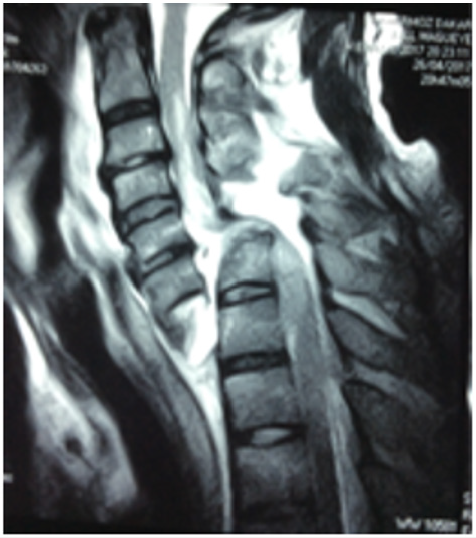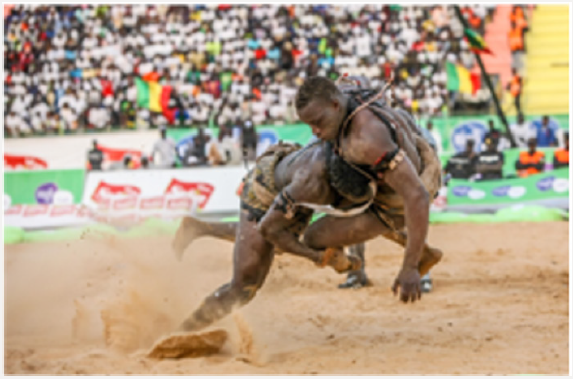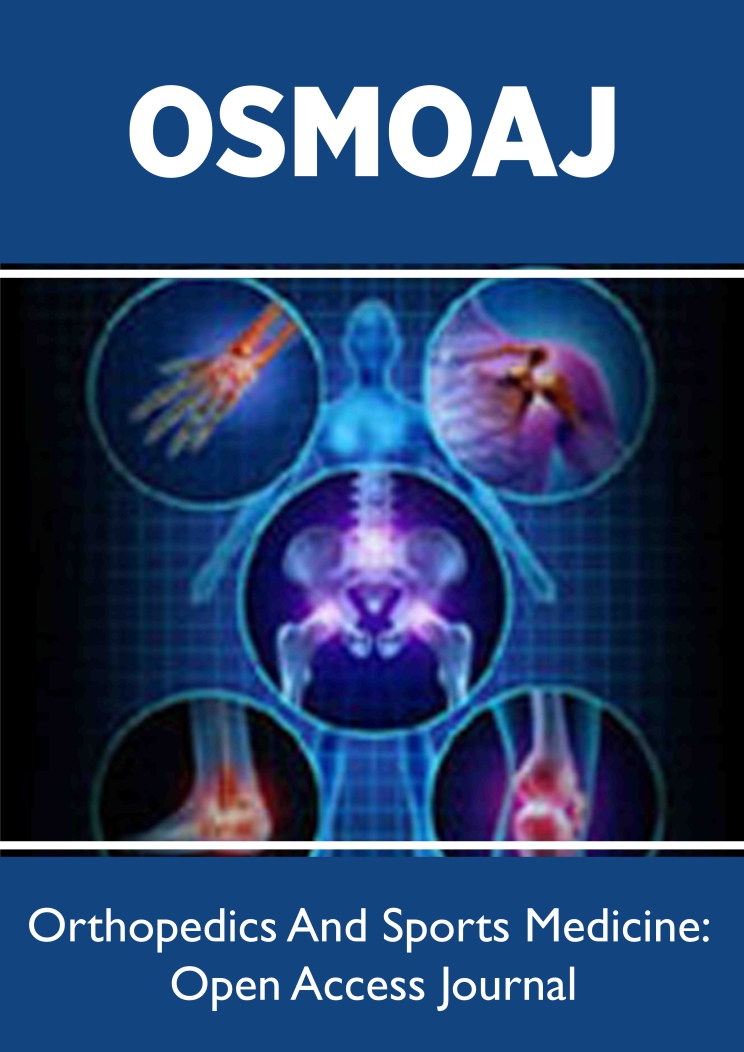
Lupine Publishers Group
Lupine Publishers
Menu
ISSN: 2638-6003
Research Article(ISSN: 2638-6003) 
Direct competitive wrestling-related catastrophic lower cervical spine injuries Volume 2 - Issue 1
Jean Marie Vianney Hope1*, Jean Claude Sane2, Souleymane Diao1, Joseph Davy Diouf1, Francis Mugabo3, Jean Paul Bitega4, Anselme Noaga Nikiema1, Amadou Ndiassé Kassé1, El Hadji Souleymane Camara1 and Mouhamadou Habib Sy1
- 1Department of Orthopedics and Trauma Surgery, Fellow West African College of Surgeons (FWACS), Grand-Yoff General Hospital, Senegal
- 2Gaston Berger University of Saint Louis, Senegal
- 3Rwanda Military Hospital, University of Rwanda, China
- 4PLA National Defense University, Beijing, China
Received: September 22, 2018 Published: October 09, 2018
Corresponding author: Jean Marie Vianney Hope, Department of Orthopedics and Trauma Surgery, Fellow West African College of Surgeons (FWACS), Grand-Yoff General Hospital, Senegal
DOI: 10.32474/OSMOAJ.2018.02.000127
Abstract
Background: Only wrestling-related catastrophic injuries in high school and collegiate wrestlers in the USA have been thorough undertaken. These injuries are either fatal, nonfatal or serious. In our environment, wrestling is now a national sport, exceeding even football in popularity. Therefore, studying the magnitude of wrestlers’ cervical spine injuries seemed needed.
Purpose: To describe the characteristics of direct competitive wrestling-related catastrophic lower cervical spine injuries and factors affecting management and outcome.
Study design: Case series; Level of evidence, 4.
Methods: This was a prospective study of 10 men professional wrestlers who sustained direct competitive wrestling-related catastrophic lower cervical spine injuries over a 5-year period. Torg for radiographic measurement, Argenson classification for lower cervical spinal injuries and the ASIA clinical scale for clinical evaluation have been used. All of the statistical calculations were performed using the SPSS.
Results: The mean age was 22.7 years (range, 17 - 28 years). A total of 10 direct catastrophic lower cervical spine injuries were identified. These are 2 fatalities, 4 nonfatal and 4 serious. The preoperative Torg value was below 8 in 9 cases and 1.2 in 1 case (mean, 0.6; range, 0.3 - 1.2). We have found 2 cases of burst fractures, 1 case of teardrop fracture, 1 case of severe sprain, 4 cases of bilateral facet fracture-dislocation and 1 case of traumatic cervical disc herniation. All cases underwent surgical management, and MPSS as adjuvant therapy was administered in 9 cases presenting with SCI. In terms of quality of life, at final follow-up, 4 cases returned in wrestling at the competitive level, 4 cases sustained permanent neurologic disabilities while 2 cases died.
Conclusion: Return to play after a direct competitive wrestling-related catastrophic lower cervical spine injury depends on clinical and radiological findings.
Keywords: Wrestling; Catastrophic Injury; Lower Cervical Spine; Return to Play
Abbreviations: NCCSIR: National Center for Catastrophic Sport Injury Research; TQ: Transient Quadriplegia; ASIA: American Spinal Injury Association; SCI: Spinal Cord Injury; SPSS: Statistical Package for Social Sciences; SD: Standard Deviation; MPSS: Methylprednisolone Sodium Succinate; CT: Computed Tomography MR: Magnetic Resonance; NASCIS: National Acute Spinal Cord Injury Study; RTP: Rate of Return to Play
Introduction
A catastrophic cervical spine injury can be defined as a structural distortion of the cervical spinal column associated with actual or potential damage to the spinal cord [1]. In the context of the lower cervical spine (C3-C7) in competitive wrestling, a catastrophe equates to the risk of significant neurologic injury. The consequences of such an injury are vast, with great personal and financial cost [2-4]. The National Center for Catastrophic Sport Injury Research (NCCSIR) in the United States of America (USA) classifies catastrophic injuries as direct (resulting from participation in the skills of a sport) or indirect (resulting from systemic failure secondary to exertion while participating in a sport) and subdivides each classification into 3 categories: fatal (the injury causes the death of the athlete), nonfatal (the injury causes a permanent neurologic functional disability) and serious (a severe injury, but the athlete has no permanent functional disability) [5-6].
Wrestling has been referred to as the most intense and physically demanding combat sport in which the risk of injury is quite high. Fortunately, the incidence of catastrophic injuries among wrestlers is extremely low [7-10]. But, it is troubling to note the unusually high number of catastrophic lower cervical spine injuries resulting from participation in wrestling. These injuries usually occur when the head is forcibly moved from one position to another; the “Whiplash” type injury. Therefore, it is critically important to monitor catastrophic cervical spine injuries and preventive strategies [6-12]. The current literature on sports injuries and health problems of wrestlers are mainly based on researches on high school and college wrestlers in the USA [13-15]. In our environment, wrestling is now a national sport, exceeding even football in popularity. Therefore, studying the magnitude of selected sports medicine problems of wrestlers seemed needed. The purpose of this study was to describe the characteristics of direct competitive wrestling-related catastrophic lower cervical spine injuries and factors affecting management and outcome.
Materials and Methods
This was a prospective study of patients treated for acute direct competitive wrestling-related catastrophic lower cervical spinal injuries from March 1, 2013, through March 31, 2018. Professional wrestlers injured during national wrestling competition were included. This study reviews all 3 categories of direct catastrophic cervical spine injuries as defined by the NCCSIR. Only traumatic conditions that typically result in a catastrophic cervical spine problem including unstable fractures and/or dislocations, transient quadriplegia (TQ) and acute central disc herniation were considered. Wrestlers with congenital spinal anomalies such as Klippel Feil syndrome and Down syndrome were excluded. Of the 413 patients with acute lower cervical spinal injury admitted during the 5-year study period, 10 patients (2.42%) satisfied our inclusion criteria. The analysis was focused on patient-related demographic characteristics (age at trauma incident), mechanism of injury, level and type of spinal injury, neurological deficit, associated injuries, management and outcome.
The American Spinal Injury Association (ASIA) classification grading system was used to document sensory and motor impairments with ASIA A: complete; B, C and D: incomplete and E: normal. Any improvement or deterioration in spinal injury grade during treatment and follow-up was documented. All the cases of death were recorded. The modified Argenson classification has been used in analyzing various lesions sustained by wrestlers; with group A: compression injuries, B: flexion-distraction injuries, C: Extension-distraction injuries, D: rotation injuries and E: traumatic cervical disc herniation. Each group is further divided into 3 subgroups according to the increasing severity of trauma [16]. The Torg index was calculated to assess the degree of spinal cord compression and when below 0.8 signifies absolute cervical stenosis, when between 0.8 and 1.2 corresponds to relative stenosis, and when above 1.2 is considered normal [17-18]. The study outcomes were the incidence rate of spinal cord injury (SCI) and in-hospital mortality. All of the statistical calculations were performed using the Statistical Package for Social Sciences (SPSS) for macOS version 24.0 (SPSS Inc. Chicago, Illinois, USA). Values for p < 0.05 were regarded as statistically significant and all confidence intervals were expressed at 95% (95% CI). Descriptive statistics were presented as number of cases, percentage and mean with standard deviation (SD).
Results
Out of 10 men wrestlers, a total of 10 injuries were identified as possible direct catastrophic lower cervical spine injuries. These injuries included 2 fatalities, 4 nonfatal and 4 serious. Injured wrestlers had a mean of 2.5-year experience of wrestling training (range, 6 months - 10 years). Only one case had a history of weight loss before the catastrophic injury. The mean age was 22.7± 5.3 years (range, 17 - 28 years). The mean follow-up time was 37.5 months (range, 3 - 60 months). The mean hospital stay was 17.11 days (range, 6 - 36 days). The leading mechanism of injury was the hyperextension and/or forced flexion (“whiplash” injury) in 6 cases, followed axial loading (compression injury) in 3 cases and rotational injury in 1 case. Associated extra-spinal injuries were bilateral Calles’ fractures in 1 case. Neurological examination on admission found ASIA grade A, C and D in 2 cases each. Three cases were ASIA grade B and 1 case ASIA grade E.
Diagnostic imaging studies, including conventional cervical radiographs were obtained in all cases. If the presence of a fracture and/or dislocation was uncertain Computed Tomography (CT) scans were required (9 cases) or if a patient had a spinal cord injury (SCI), magnetic resonance (MR) was obtained (9 cases). Imaging results showed the level and type of injuries with vertebral body fractures in 3 cases (C5 involved in 2 cases and C6 in 1 case). C3-C4 traumatic cervical disc herniation was found in 1 case and 6 cases presented dislocations with or without fractures (C4-C5 level in 3 cases, C5-C6 level in 2 cases and C6-C7 level in 1 case). According to Argenson classification, there were 2 cases with AII type injury (burst fractures of vertebral body), 1 case with AIII type injury (tear drop fracture), 1 case with BII type injury (severe sprain), 4 cases with CIII type injury (bilateral facet fracture-dislocation), 1 case with DIII type injury (unilateral facet dislocation) and 1 case with E type injury (traumatic cervical disc herniation). The subgroups AII, AIII and CIII (Figure 1) were responsible of complete spinal cord injury (tetraplegia) in 1 case each. The preoperative Torg index was below 8 in 9 cases and 1.2 in 1 case (mean, 0.6; range, 0.3 - 1.2). With regard to the relationship between cervical spinal cord injury and radiological Torg index, a significant correlation (P=0.0382, chisquare test) was noted between Torg index value and the degree of clinical impairment of the participants. The decrease in Torg values was directly proportional to clinical worsening on the ASIA scale.
Figure 1: Preoperative sagittal T2-weighted MRI scan of a 26 years old wrestlers revealing a fracture dislocation of the C6-C7 with overlapping of C7 at C5 level type CIII of the Argenson classification, Torg index value 0.3 and severe spinal cord contusion without transection tetraplegic ASIA grade A.

The mean operation time was 48 hours post injury (range, 24 hours - 5 days). Six cases underwent discectomy and/or corporectomy, insertion of an autologous iliac crest graft and fixation with cervical plate while 4 cases (Figure 2) were operated using the posterior approach. Methylprednisolone sodium succinate (MPSS) was administered in 9 cases with neurologic deficit. Control radiographs showed good realignment of the cervical spine column in all cases (Figure 3). All of the incisions were with primary healing. Rehabilitation was systematic thereafter. Throughout the follow-up, 1 case presented pressure ulcers and required extensive debridement and skin graft thereafter. At the mean follow-up time, 4 cases have recovered from neurologic deficit (ASIA grade E), 3 cases have partial recovery while 2 cases remained stationary. Two cases died 7 days after operation. They were ASIA grade A and B respectively. The injury responsible of death were classified Argenson AII and AIII. In terms of quality of life, at final follow-up, 4 cases returned in wrestling at the competitive level (Figure 4) and the remaining 4 cases sustained permanent functional neurologic disabilities.
Figure 1: Immediate postoperative sagittal CT scan showing good realignment after reduction, corporectomy of C6, discectomy C5-C6 and C6-C7, insertion of autologous iliac crest graft and anterior fixation of the C5- C7 with Caspar plate.

Figure 3: Postoperative lateral radiograph 3 months postoperatively showing a well-fixed anterior plate.

Figure 4: Photograph 4 years later showing a wrestler (right man) in action at highly competitive level after recovering neurologic functions.

Discussion
Sporting events are the fourth most common cause of spinal cord injury behind motor vehicle accidents, violence, and falls. In contrast to the other major causes of spinal cord injury, sportsrelated spinal cord injuries occur at a mean age of 24. In fact, in the first 3 decades of life, sports injuries are the second most common cause of spinal cord injury [1-15], [19,20]. Wrestling has the highest rate of catastrophic injuries to the cervical spine [7]. However, these injuries may be preventable with proper technique and instruction [4-11]. In our series, the mean age was 22.7 years ranging from 17 to 28 years. Injury prevention was focused on education by coaches and referee on the regulations during the wrestling maneuver, the quality of the infrastructures (stadium), proper in-field initial and hospital management.
The rates of catastrophic injuries among wrestlers in boy high school and collegiate wrestlers in the USA per 100,000 participants/ year are 0.95 and 0.61 respectively. Fatality in high school wrestler counts 0.05, nonfatal injuries in high school and collegiate wrestlers count 0.59 and 0.61 respectively while serious injuries were valued at 0.31 in high school wrestlers. No fatality and serious injuries in collegiate wrestlers [3-8, 13]. In this study, the calculated direct catastrophic lower cervical spine injury rates among 10 wrestlers were 0.2 for fatalities (2 cases) and 0.4 for nonfatal and serious injuries (4 cases each). They occurred as consequences of three conditions including unstable fractures and/or dislocations, TQ and traumatic cervical disc herniation. The rate of fatality was about four times higher than high school wrestlers in the USA and the rates of nonfatal and serious injuries are almost the same as among high school and collegiate wrestlers in the USA. This difference was particularly marked because of the differences between the fatality rates. These differences might be because of different factors such as differences in the level of coaching supervision during wrestling training and differences in health care levels as well as a higher quality of facilities in the wrestling clubs in the USA compared with our environment. Moreover, the wrestling practiced is type of folk wrestling.
Different mechanisms of injury have been described. Phillip R. Langer [9] showed that the most frequent injury vector associated with cervical SCI is the axial compression. Based on the notion of dominant lesional vector force, Claude Argenson [16] have proposed 4 main injury mechanisms. The compression injury vector is produced when an axial force is applied to the vertex of the wrestler’s head during the fall head-first. There are 2 major patterns of spinal column damage caused by compressive load: the compression-flexion fracture (historically termed a ‘’flexion teardrop’’ injury), and the vertical compression (or ‘’burst’’) fracture. The second mechanism of injury is the “whiplash” type injury which is either flexion-distraction or extension-distraction. This mechanism is responsible for severe sprains, bilateral facet fracture-dislocation and traumatic cervical disc herniation. The rotation injuries are unilateral facet fracture, fracture-separation of the articular pillar and unilateral facet dislocation. In our series, we have found 2 cases of burst fractures, 1 case of teardrop fracture, 1 case of severe sprain, 4 cases of bilateral facet fracture-dislocation and 1 case of traumatic cervical disc herniation.
Proper treatment of spine injuries in high-level wrestlers is of paramount importance to ensure player safety as well as avoid problems with medico-legal issues. Treatment options include conservative treatment for stable injuries and stabilization and fusion for unstable injuries, often combined with surgical decompression. Surgical treatment may provide a higher rate of return to play (RTP) for these wrestlers than nonsurgical treatment [21-23]. The functional outcomes depend on initial neurological status and proper management [18-26]. For adjuvant therapy in patients presenting with SCI, MPSS administration protocols of the National Acute Spinal Cord Injury Study (NASCIS) borne from the NASCIS I, II and III studies are now recommended as an “option” only [27]. In general, patients who are completely pain free with full range of motion and strength may be eligible for RTP if no other injuries are present [7-28]. In our series, Life support principles guide initial management. Surgical fixation has been performed in all cases and MPSS has been used in 9 cases with SCI. After conducting this study, using methods such as Torg for radiographic measurement, Argenson classification and the ASIA clinical scale for clinical evaluation of direct catastrophic lower cervical spinal injury, we observed a directly proportional correlation between the degree of cervical spinal cord injury and the clinical deterioration. All injured wrestlers received exercise therapy which is considered an important part in the treatment and rehabilitation. The decision to return a wrestler to a competition after a catastrophic lower cervical spine injury was individualized based on mechanism of injury, anatomical site, imaging studies, and the wrestler’ recovery response. Only 4 wrestlers returned to competition.
The primary limitation of our study is that it was conducted on a small population. Therefore, further large-scale studies are needed to make strong recommendations. Additionally, while our trauma registry captures injuries presenting to the hospital Emergency Department, it does not address minor wrestling injuries that are seen in a non-acute care setting or managed by coaches or trainers. These minor injuries likely make up the majority of wrestling injury encounters, making our description a significant underestimate of overall injury incidence.
Conclusion
Direct competitive wrestling-related catastrophic lower cervical spine injuries are preventable by emphasizing on the regulations during wrestling manoeuver. However, when they occur, surgical decompression of neural elements, restoration of cervical column alignment, stabilization and fusion may provide a higher rate of RTP. Wrestlers who are completely pain free with full range of motion and strength may be eligible for RTP.
References
- Banerjee R, Palumbo MA, Fadale PD (2004) Catastrophic cervical spine injuries in the collision sport athlete. Part 1: epidemiology, functional anatomy, and diagnosis. Am J Sports Med 32(4): 1077-1087.
- Ackery A, Hagel BE, Provvidenza C, Tator CH (2007) An international review of head and spinal cord injuries in alpine skiing and snowboarding. Inj Prev 13(6): 368-375.
- Hutton MJ, McGuire RA, Dunn R, Williams R, Robertson P, et al. (2016) Catastrophic cervical spine injuries in contact sports. Global Spine J 6(7): 721-734.
- Maliachovas NK, Klukowska-Rötzler J, Sauter TC, Lehmann B, Krummrey G, et al. (2018) Severity and pattern of injuries caused by Swiss wrestling (Schwingen): first retrospective study at a level I University Emergency Department in Switzerland. BMJ Open Sport Exerc Med 13(4): e000270.
- Ball G (1997) Catastrophic Injuries in High School and College Sports. J Athl Train 32(1): 79-80.
- Boden BP, Tacchetti RL, Cantu RC, Knowles SB, Mueller FO (2006) Catastrophic cervical spine injuries in high school and college football players. Am J Sports Med 34(8):1223-1232.
- Kleeman LT, Gallizzi MA, Blizzard DJ, Ericksson MM (2015) Cervical spinal injuries in sports. The Duke Orthop J 5(1): 58-62.
- Kordi R, Akbarnejad A, Wallace WA. (2010) Catastrophic injuries in the Olympic styles of wrestling in Iran. Br J Sports Med 44(3): 168-174.
- Langer PR, Fadale PD, Palumbo MA (2008) Catastrophic Neck Injuries in the Collision Sport Athlete. Sports Med Arthrosc Rev 16(1): 7-15.
- Perri BR and Lynch SA (2003) Common injuries in the skilled wrestler. Curr Opin Orthop 14(2): 109-113.
- Bailes JE, Petschauer M, Guskiewicz KM, Marano G (2007) Management of cervical spine injuries in athletes. Journal of Athletic Training 42(1): 126-134.
- Narayana Kurup JK, Jampani R, Mohanty SP (2017) Catastrophic cervical spinal injury in an amateur college wrestler. BMJ Case Rep pp. 220260.
- Kordi R, Ziaee V, Rostami M, Wallace WA (2012) Sports injuries and health problems among wrestlers in Tehran. J Pak Med Assoc 62(3): 204-208.
- Myers RJ, Linakis SW, Mello MJ, Linakis JG (2010) Competitive wrestlingrelated injuries in school aged athletes in U.S. Emergency Departments. West J Emerg Med 11(5) :442-449.
- Wu WQ, Lewis RC (1985) Injuries of the cervical spine in high school wrestling. Surg Neurol 23(2): 143-147.
- Argenson C, De Peretti F, Eude P, Lovet J, Hovorka I (1997) Classification of lower cervical spine injuries. Eur J Orthop Surg Traumatol 7(4): 215- 229.
- Torg JS, Pavlov H, Genuario SE, Sennett B, Wisneski RJ, et al. (1986) Neurapraxia of the cervical spinal cord with transient quadriplegia. J Bone Joint Surg Am 68(9): 1354-1370.
- Lozorio AR, Borges M, Batista Junior JL, Chacob Junior C, Machado IC, et al. (2012) Correlation between the clinic and the index of cervical myelopathy Torg. Acta Ortop Bras 20(3): 180-183.
- DeVivo MJ (1997) Causes and costs of spinal cord injury in the United States. Spinal Cord 35(12): 809-813.
- Carll KE, Park AE, Tortolani PJ (2010) Epidemiology of catastrophic spine injuries in high school, college, and professional sports. Semin Spine Surg 22: 168-172.
- Joaquim AF, Hsu WK, Patel AA (2016) Cervical spine surgery in professional athletes: a systematic review. Neurosurg Focus 40(4): E10.
- O Dowd JK (2010) Basic principles of management for cervical spine trauma. Eur Spine J 19(1): 18-22.
- Schleicher P, Pingel A, Kandziora F (2018) Safe management of acute cervical spine injuries. EFORT Open Rev 3(5): 347-357.
- Nakagawa Y, Mukai S, Minami K, Hattori Y, Nakamura T (2017) Radiological changes in the cervical spine in freshman collegiate sumo wrestlers. Orthop J Sports Med 5(12).
- Torg JS, Sennett B, Pavlov H, Leventhal MR, Glasgow SG (1993) Spear tackler’s spine. An entity precluding participation in tackle football and collision activities that expose the cervical spine to axial energy inputs. Am J Sports Med 21(5): 640-649.
- Zahir U, Ludwig SC (2010) Sports-related cervical spine injuries: onfield assessment and management. Semin Spine Surg 22(4):173-180.
- Wang S, Hawryluk GWJ, Spano S, Fehlings MG (2010) Pharmacologic protocols for spinal cord-injured athletes. Semin Spine Surg 22(4): 181- 192.
- Cantu RC, Li YM, Abdulhamid M, Chin LS (2013) Return to play after cervical spine injury in sports. Curr Sports Med Rep 12(1): 14-17.

Top Editors
-

Mark E Smith
Bio chemistry
University of Texas Medical Branch, USA -

Lawrence A Presley
Department of Criminal Justice
Liberty University, USA -

Thomas W Miller
Department of Psychiatry
University of Kentucky, USA -

Gjumrakch Aliev
Department of Medicine
Gally International Biomedical Research & Consulting LLC, USA -

Christopher Bryant
Department of Urbanisation and Agricultural
Montreal university, USA -

Robert William Frare
Oral & Maxillofacial Pathology
New York University, USA -

Rudolph Modesto Navari
Gastroenterology and Hepatology
University of Alabama, UK -

Andrew Hague
Department of Medicine
Universities of Bradford, UK -

George Gregory Buttigieg
Maltese College of Obstetrics and Gynaecology, Europe -

Chen-Hsiung Yeh
Oncology
Circulogene Theranostics, England -
.png)
Emilio Bucio-Carrillo
Radiation Chemistry
National University of Mexico, USA -
.jpg)
Casey J Grenier
Analytical Chemistry
Wentworth Institute of Technology, USA -
Hany Atalah
Minimally Invasive Surgery
Mercer University school of Medicine, USA -

Abu-Hussein Muhamad
Pediatric Dentistry
University of Athens , Greece

The annual scholar awards from Lupine Publishers honor a selected number Read More...










